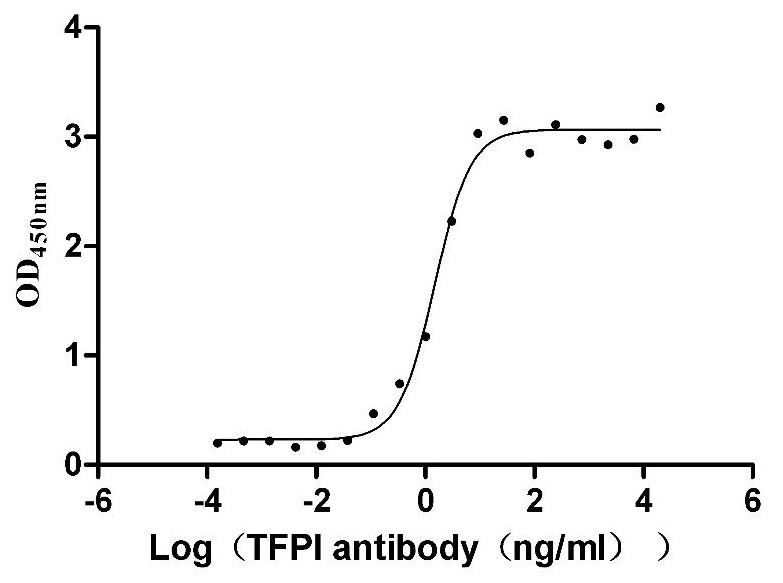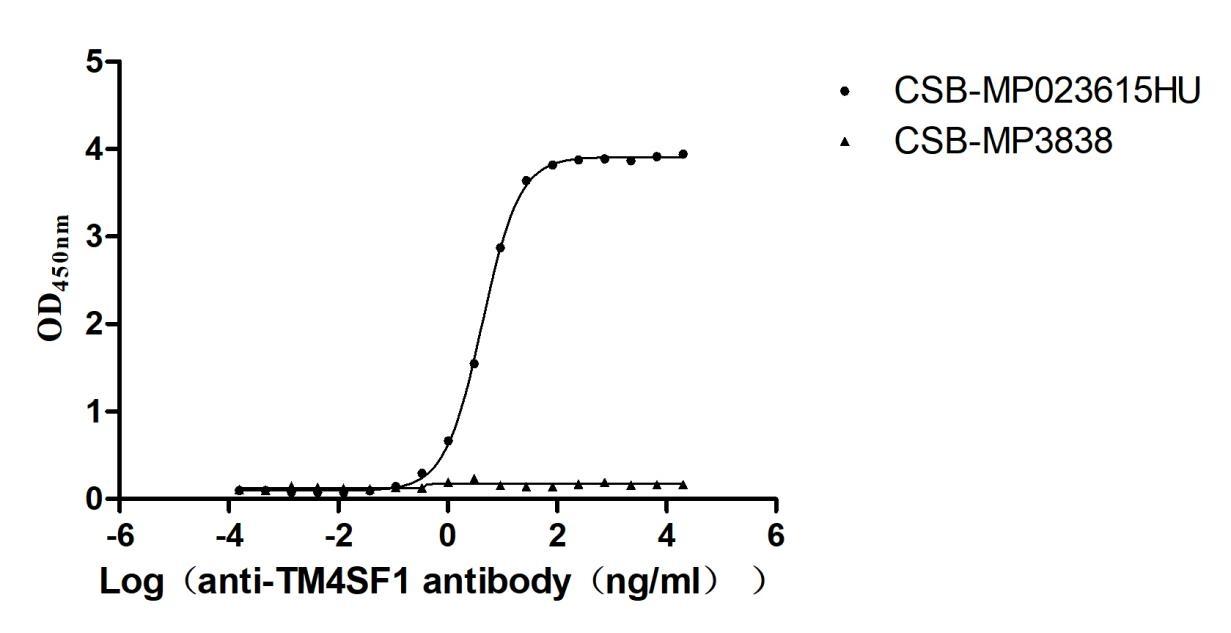Recombinant Saccharomyces cerevisiae Histone acetyltransferase GCN5 (GCN5)
-
中文名稱(chēng):釀酒酵母GCN5重組蛋白
-
貨號(hào):CSB-YP312691SVG
-
規(guī)格:
-
來(lái)源:Yeast
-
其他:
-
中文名稱(chēng):釀酒酵母GCN5重組蛋白
-
貨號(hào):CSB-EP312691SVG
-
規(guī)格:
-
來(lái)源:E.coli
-
其他:
-
中文名稱(chēng):釀酒酵母GCN5重組蛋白
-
貨號(hào):CSB-EP312691SVG-B
-
規(guī)格:
-
來(lái)源:E.coli
-
共軛:Avi-tag Biotinylated
E. coli biotin ligase (BirA) is highly specific in covalently attaching biotin to the 15 amino acid AviTag peptide. This recombinant protein was biotinylated in vivo by AviTag-BirA technology, which method is BriA catalyzes amide linkage between the biotin and the specific lysine of the AviTag.
-
其他:
-
中文名稱(chēng):釀酒酵母GCN5重組蛋白
-
貨號(hào):CSB-BP312691SVG
-
規(guī)格:
-
來(lái)源:Baculovirus
-
其他:
-
中文名稱(chēng):釀酒酵母GCN5重組蛋白
-
貨號(hào):CSB-MP312691SVG
-
規(guī)格:
-
來(lái)源:Mammalian cell
-
其他:
產(chǎn)品詳情
-
純度:>85% (SDS-PAGE)
-
基因名:GCN5
-
Uniprot No.:
-
別名:GCN5; ADA4; SWI9; YGR252WHistone acetyltransferase GCN5; EC 2.3.1.48
-
種屬:Saccharomyces cerevisiae (strain ATCC 204508 / S288c) (Baker's yeast)
-
蛋白長(zhǎng)度:full length protein
-
表達(dá)區(qū)域:1-439
-
氨基酸序列MVTKHQIEED HLDGATTDPE VKRVKLENNV EEIQPEQAET NKQEGTDKEN KGKFEKETER IGGSEVVTDV EKGIVKFEFD GVEYTFKERP SVVEENEGKI EFRVVNNDNT KENMMVLTGL KNIFQKQLPK MPKEYIARLV YDRSHLSMAV IRKPLTVVGG ITYRPFDKRE FAEIVFCAIS STEQVRGYGA HLMNHLKDYV RNTSNIKYFL TYADNYAIGY FKKQGFTKEI TLDKSIWMGY IKDYEGGTLM QCSMLPRIRY LDAGKILLLQ EAALRRKIRT ISKSHIVRPG LEQFKDLNNI KPIDPMTIPG LKEAGWTPEM DALAQRPKRG PHDAAIQNIL TELQNHAAAW PFLQPVNKEE VPDYYDFIKE PMDLSTMEIK LESNKYQKME DFIYDARLVF NNCRMYNGEN TSYYKYANRL EKFFNNKVKE IPEYSHLID
-
蛋白標(biāo)簽:Tag?type?will?be?determined?during?the?manufacturing?process.
The tag type will be determined during production process. If you have specified tag type, please tell us and we will develop the specified tag preferentially. -
產(chǎn)品提供形式:Lyophilized powder
Note: We will preferentially ship the format that we have in stock, however, if you have any special requirement for the format, please remark your requirement when placing the order, we will prepare according to your demand. -
復(fù)溶:We recommend that this vial be briefly centrifuged prior to opening to bring the contents to the bottom. Please reconstitute protein in deionized sterile water to a concentration of 0.1-1.0 mg/mL.We recommend to add 5-50% of glycerol (final concentration) and aliquot for long-term storage at -20℃/-80℃. Our default final concentration of glycerol is 50%. Customers could use it as reference.
-
儲(chǔ)存條件:Store at -20°C/-80°C upon receipt, aliquoting is necessary for mutiple use. Avoid repeated freeze-thaw cycles.
-
保質(zhì)期:The shelf life is related to many factors, storage state, buffer ingredients, storage temperature and the stability of the protein itself.
Generally, the shelf life of liquid form is 6 months at -20°C/-80°C. The shelf life of lyophilized form is 12 months at -20°C/-80°C. -
貨期:Delivery time may differ from different purchasing way or location, please kindly consult your local distributors for specific delivery time.Note: All of our proteins are default shipped with normal blue ice packs, if you request to ship with dry ice, please communicate with us in advance and extra fees will be charged.
-
注意事項(xiàng):Repeated freezing and thawing is not recommended. Store working aliquots at 4°C for up to one week.
-
Datasheet :Please contact us to get it.
靶點(diǎn)詳情
-
功能:Acetylates histone H2B to form H2BK11ac and H2BK16ac, histone H3 to form H3K9ac, H3K14ac, H3K18ac, H3K23ac, H3K27ac and H3K36ac, with a lower preference histone H4 to form H4K8ac and H4K16ac, and contributes to H2A.Z acetylation. Acetylation of histones gives a specific tag for epigenetic transcription activation. Operates in concert with certain DNA-binding transcriptional activators such as GCN4 or HAP2/3/4. Its acetyltransferase activity seems to be dependent on the association in different multisubunit complexes. Functions as histone acetyltransferase component of the transcription regulatory histone acetylation (HAT) complexes SAGA, SALSA and ADA. SAGA is involved in RNA polymerase II-dependent transcriptional regulation of approximately 10% of yeast genes. At the promoters, SAGA is required for recruitment of the basal transcription machinery. It influences RNA polymerase II transcriptional activity through different activities such as TBP interaction (SPT3, SPT8 and SPT20) and promoter selectivity, interaction with transcription activators (GCN5, ADA2, ADA3 and TRA1), and chromatin modification through histone acetylation (GCN5) and deubiquitination (UBP8). SAGA acetylates nucleosomal histone H3 to some extent (to form H3K9ac, H3K14ac, H3K18ac and H3K23ac). SAGA interacts with DNA via upstream activating sequences (UASs). SALSA, an altered form of SAGA, may be involved in positive transcriptional regulation. The ADA histone acetyltransferase complex preferentially acetylates nucleosomal histones H3 (to form H3K14ac and H3K18ac) and H2B, leading to transcription regulation. SLIK is proposed to have partly overlapping functions with SAGA. It preferentially acetylates methylated histone H3, at least after activation at the GAL1-10 locus.
-
基因功能參考文獻(xiàn):
- It conserved Spt-Ada-Gcn5 acetyltransferase (SAGA) complex as a paradigm to illustrate how co-activators share and combine a relatively limited set of functional tools. PMID: 28964624
- In this study it has been demonstrated for the first time that Gcn5 and SAGA are needed for respiratory metabolism and oxygen consumption. PMID: 27741413
- We find that RTS1, one of two genes encoding PP2A regulatory subunits, is a robust and specific high-copy suppressor of temperature sensitivity of gcn5 and a subset of other gcn5 phenotypes PMID: 27317677
- e describe here our observation of both full length and a truncated form of a yeast protein (Gcn5) expressed in Escherichia coli, and the reduction or elimination of the truncated form by mutating a cryptic Shine-Dalgarno or START codon within the Gcn5 coding region. PMID: 26739786
- Gcn5, Snf2, and Ydj1 cooperate in eviction of promoter nucleosomes genome-wide, achieving robust transcription of the most highly expressed subset of genes in yeast. PMID: 26602697
- Gcn5 plays an important role in the regulatory network of FLO11 expression via Gcn4 by downregulating ICR1 expression, which derepresses FLO11 for promoting pseudohyphal development PMID: 25922832
- the Gcn5 bromodomain contributes to lysine specificity and is necessary for processive acetylation on histone H3. PMID: 25106422
- Acetylome profiling reveals overlap in the regulation of diverse processes by sirtuins, gcn5, and esa1 PMID: 25381059
- NuA4 and Gcn5 enzymes are both required for the robust recruitment of SWI/SNF to a DSB, which in turn promotes the phosphorylation of H2A.X. PMID: 25869823
- Gcn5-dependent H3K36 acetylation increases chromatin accessibility, increases resection and promotes homologous recombination DNA repair. PMID: 24909977
- an alternative explanation for previously indicated repressive role of Gcn5 in gene transcription PMID: 23865462
- we show that under derepressing conditions the recruitment of the histone acetyltransferase Gcn5 is abolished by SNF1 deletion, possibly explaining the lack of increased histone H3 acetylation and nucleosome remodelling PMID: 22306658
- Data support a model in which p23 molecular chaperone and GCN5 regulate diverse multistep pathways by controlling the longevity of protein-DNA complexes. PMID: 23022381
- We present our working model in which Elp3/Gcn5 and the APC work together to facilitate passage through mitosis and G(1). To progress into S, we propose that at least Gcn5 must then be targeted for degradation in an APC-dependent fashion. PMID: 20709786
- Gcn5 regulates divergent sets of KCl responsive genes in S. cerevisiae and S. pombe. PMID: 20338033
- propose that GCN5 acts as a positive regulator of DNA replication by counteracting the inhibitory effect of Histone Deacetylases PMID: 20126453
- show that Gcn5, a KAT that functions in transcription, works in parallel with Rtt109, the H3 lysine 56 KAT, to promote replication-coupled nucleosome assembly. PMID: 20188666
- The HatB3.1 complex is a novel histone H3-specific type B histone acetyltransferase that contains Gcn5p and Ada3p, but not Ada2p. Gcn5p appears to be the catalytic subunit of HatB3.1. PMID: 15274751
- The importance of amino acidic residues present in the bromodomain of the histone acetyltransferase Gcn5p. PMID: 16180204
- Gcn5 sumoylation may have an inhibitory role in transcriptional regulation PMID: 16411780
- results show correlation between transcriptional regulation by Gcn5p and by histone H3 amino terminus indicating that H3 tail plays a small but significant positive role in transcriptional activation of Gcn5p PMID: 16461773
- Gcn5p regulates transcription and DNA repair at the MET16 gene. PMID: 16473851
- a role for global Gcn5 activity in modulating transcription independently of its known coactivator function PMID: 16478983
- These investigators have characterized the genome-wide gene expression responses to KCl stress and show that Gcn5 is involved in the regulation of a subset of stress response genes. PMID: 16896217
- The combined action of GCN5 and Abf1p determines the bidirectional capacity of the UGA3-GLT1 intergenic region. PMID: 16904075
- Gcn5p, most likely in SAGA, stimulates modification and eviction of nucleosomes in transcribed coding sequences and promotes Pol II elongation. PMID: 17218269
- The HATs (histone acetyltransferases) Gcn5 (general control non-derepressible 5) and Elp3 (elongation protein 3) modulated hsp70 gene transcription by affecting the acetylation status of histone H3. PMID: 17910533
- Gcn5p is physically linked to the centromere, where it affects the structure of the variant centromeric nucleosome. PMID: 18039853
- Rsc4p is acetylated at lysine 25 by Gcn5p PMID: 18809572
- Data sugegst that Esa1 cooperates with Gcn5 to mediate acetylation and occupancy and histone eviction in coding sequences and stimulates the rate of transcription elongation. PMID: 19822662
- report the discovery that Gcn5, which encodes the histone acetyltransferase (HAT) activity of the SAGA complex, has genetic interactions with the genes encoding the heterodimeric U2 snRNP proteins Msl1 and Lea1. PMID: 19834536
顯示更多
收起更多
-
亞細(xì)胞定位:Nucleus.
-
蛋白家族:Acetyltransferase family, GCN5 subfamily
-
數(shù)據(jù)庫(kù)鏈接:
KEGG: sce:YGR252W
STRING: 4932.YGR252W
Most popular with customers
-
Recombinant Human Glypican-3 (GPC3) (G537R), partial (Active)
Express system: Mammalian cell
Species: Homo sapiens (Human)
-
Recombinant Human Tissue factor pathway inhibitor (TFPI), partial (Active)
Express system: Mammalian cell
Species: Homo sapiens (Human)
-
Recombinant Rat Intestinal-type alkaline phosphatase 1 (Alpi) (Active)
Express system: Mammalian cell
Species: Rattus norvegicus (Rat)
-
Recombinant Mouse Transthyretin (Ttr) (Active)
Express system: Mammalian cell
Species: Mus musculus (Mouse)
-
Recombinant Human C-C chemokine receptor type 8 (CCR8)-VLPs (Active)
Express system: Mammalian cell
Species: Homo sapiens (Human)
-
Recombinant Human Interleukin-2 (IL2) (Active)
Express system: Mammalian cell
Species: Homo sapiens (Human)
-
Recombinant Human Transmembrane 4 L6 family member 1(TM4SF1)-VLPs (Active)
Express system: Mammalian cell
Species: Homo sapiens (Human)


-AC1.jpg)
















